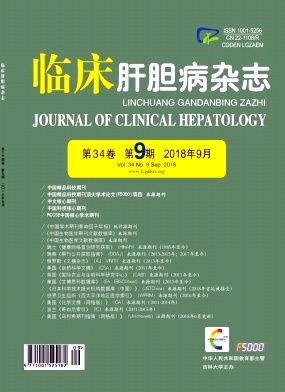|
[1]PERZ JF, ARMSTRONG GL, FARRINGTON LA, et al.The contributions of hepatitis B virus and hepatitis C virus infections to cirrhosis and primary liver cancer worldwide[J].J Hepatol, 2006, 45 (4) :529-538.
|
|
[2]FORNER A, LLOVET JM, BRUIX J.Hepatocellular carcinoma[J].Lancet, 2012, 379 (9822) :1245-1255.
|
|
[3]National Health and Family Planning Commission of the People's Republic of China.Diagnosis, management, and treatment of hepatocellular carcinoma (V2017) [J].J Clin Hepatol, 2017, 33 (8) :1419-1431. (in Chinese) 中华人民共和国国家卫生和计划生育委员会.原发性肝癌诊疗规范 (2017年版) [J].临床肝胆病杂志, 2017, 33 (8) :1419-1431.
|
|
[4]Chinese Society of Liver Cancer, Chinese Anti-Cancer Association;Liver Cancer Study Group, Chinese Society of Hepatology, Chinese Medical Association;Chinese Society of Pathology, Chinese Anti-Cancer Association, et al.Evidence-based practice guidelines for the standardized pathological diagnosis of primary liver cancer in China (2015 update) [J].J Clin Hepatol, 2015, 31 (6) :833-839. (in Chinese) 中国抗癌协会肝癌专业委员会, 中华医学会肝病学分会肝癌学组, 中国抗癌协会病理专业委员会, 等.原发性肝癌规范化病理诊断指南 (2015年版) [J].临床肝胆病杂志, 2015, 31 (6) :833-839.
|
|
[5]AHN SY, LEE JM, JOO I, et al.Prediction of microvascular invasion of hepatocellular carcinoma using gadoxetic acid-enhanced MR and (18) F-FDG PET/CT[J].Abdom Imaging, 2015, 40 (4) :843-851.
|
|
[6]HU H, ZHENG Q, HUANG Y, et al.A non-smooth tumor margin on preoperative imaging assesses microvascular invasion of hepatocellular carcinoma:A systematic review and meta-analysis[J].Sci Rep, 2017, 7 (1) :15375.
|
|
[7]REGINELLI A, VANZULLI A, SGRAZZUTTI C, et al.Vascular microinvasion from hepatocellular carcinoma:CT findings and pathologic correlation for the best therapeutic strategies[J].Med Oncol, 2017, 34 (5) :93.
|
|
[8]YANG C, WANG H, TANG Y, et al.ADC similarity predicts microvascular invasion of bifocal hepatocellular carcinoma[J].Abdom Radiol (NY) , 2018.[Epub ahead of print]
|
|
[9]HYUN SH, EO JS, SONG BI, et al.Preoperative prediction of microvascular invasion of hepatocellular carcinoma using 18F-FDGPET/CT:A multicenter retrospective cohort study[J].Eur J Nucl Med Mol Imaging, 2018, 45 (5) :720-726.
|
|
[10]EGUCHI S, TAKATSUKI M, HIDAKA M, et al.Predictor for histological microvascular invasion of hepatocellular carcinoma:A lesson from 229 consecutive cases of curative liver resection[J].World J Surg, 2010, 34 (5) :1034-1038.
|
|
[11]FAN LF, ZHAO WC, YANG N, et al.Alpha-fetoprotein:The predictor of microvascular invasion in solitary small hepatocellular carcinoma and criterion for anatomic or non-anatomic hepatic resection[J].Hepatogastroenterology, 2013, 60 (124) :825-836.
|
|
[12]SHIRABE K, ITOH S, YOSHIZUMI T, et al.The predictors of microvascular invasion in candidates for liver transplantation with hepatocellular carcinoma-with special reference to the serum levels of des-gamma-carboxy prothrombin[J].J Surg Oncol, 2007, 95 (3) :235-240.
|
|
[13]POTN, CAUCHY F, ALBUQUERQUE M, et al.Performance of PIVKA-II for early hepatocellular carcinoma diagnosis and prediction of microvascular invasion[J].J Hepatol, 2015, 62 (4) :848-854.
|
|
[14]REN Y, POON RT, TSUI HT, et al.Interleukin-8 serum levels in patients with hepatocellular carcinoma:Correlations with clinicopathological features and prognosis[J].Clin Cancer Res, 2003, 9 (16 Pt 1) :5996-6001.
|
|
[15]CAO GL, CAI Q, LI YA, et al.Risk factors analysis and prognosis of the microvascular invasion of hepatocellular carcinoma[J].Chin J Dig Surg, 2017, 16 (10) :1048-1052. (in Chinese) 曹国良, 蔡庆, 李幼安, 等.肝细胞癌微血管侵犯的危险因素分析及预后[J].中华消化外科杂志, 2017, 16 (10) :1048-1052.
|
|
[16]YU Y, SONG J, ZHANG R, et al.Preoperative neutrophil-tolymphocyte ratio and tumor-related factors to predict microvascular invasion in patients with hepatocellular carcinoma[J].Oncotarget, 2017, 8 (45) :79722-79730.
|
|
[17]BRUIX J, SHERMAN M;Practice Guidelines Committee, American Association for the Study of Liver Diseases.Management of hepatocellular carcinoma[J].Hepatology, 2005, 42 (5) :1208-1236.
|
|
[18]RODRGUEZ-PERLVAREZ M, LUONG TV, ANDREANA L, et al.A systematic review of microvascular invasion in hepatocellular carcinoma:Diagnostic and prognostic variability[J].Ann Surg Oncol, 2013, 20 (1) :325-339.
|
|
[19]ZHAO H, HUA Y, LU Z, et al.Prognostic value and preoperative predictors of microvascular invasion in solitary hepatocellular carcinoma≤5 cm without macrovascular invasion[J].Oncotarget, 2017, 8 (37) :61203-61214.
|
|
[20]RENZULLI M, BROCCHI S, CUCCHETTI A, et al.Can current preoperative imaging be used to detect microvascular invasion of hepatocellular carcinoma?[J].Radiology, 2016, 279 (2) :432-442.
|
|
[21]ZHENG J, SEIER K, GONEN M, et al.Utility of serum inflammatory markers for predicting microvascular invasion and survival for patients with hepatocellular carcinoma[J].Ann Surg Oncol, 2017, 24 (12) :3706-3714.
|
|
[22]IMURA S, TERAOKU H, YOSHIKAWA M, et al.Potential predictive factors for microvascular invasion in hepatocellular carcinoma classified within the Milan criteria[J].Int J Clin Oncol, 2018, 23 (1) :98-103.
|
|
[23]HUSSAIN SP, HARRIS CC.Inflammation and cancer:An ancient link with novel potentials[J].Int J Cancer, 2007, 121 (11) :2373-2380.
|
|
[24]OUYANG B, QIU YL, WANG YX, et al.Study of TSGF, AFPand GGT in the diagnosis of primary hepatic carcinoma[J].Shenzhen J Integr Tradit Chin West Med, 2016, 26 (5) :6-8. (in Chinese) 欧阳彬, 丘燕丽, 汪云霞.TSGF、AFP、GGT联合诊断原发性肝癌的临床价值[J].深圳中西医结合杂志, 2016, 26 (5) :6-8.
|
|
[25]WEI X, LI N, LI S, et al.Hepatitis B virus infection and active replication promote the formation of vascular invasion in hepatocellular carcinoma[J].BMC Cancer, 2017, 17 (1) :304.
|
|
[26]ZHENG B, ZHU YJ, WANG HY, et al.Gender disparity in hepatocellular carcinoma (HCC) :Multiple underlying mechanisms[J].Sci China Life Sci, 2017, 60 (6) :575-584.
|
|
[27]RUGGIERI A, BARBATI C, MALORNI W.Cellular and molecular mechanisms involved in hepatocellular carcinoma gender disparity[J].Int J Cancer, 2010, 127 (3) :499-504.
|
|
[28]BAI SL, YANG PH, LI J, et al.Effect of microvascular invasion on postoperative long-term prognosis of small and large hepatocellular carcinoma[J/CD].Chin J Hepatic Surg:Electronic Edition, 2017, 6 (3) :207-211. (in Chinese) 白石磊, 杨平华, 李俊, 等.微血管侵犯对小肝细胞癌和大肝细胞癌术后远期预后的影响[J/CD].中华肝脏外科手术学电子杂志, 2017, 6 (3) :207-211.
|
|
[29]SHEN J, LI C, YAN L, et al.Short-and long-term outcomes between young and older HCC patients exceeding the milan criteria after hepatectomy[J].Ann Hepatol, 2018, 17 (1) :134-143.
|
|
[30]HUANG C, ZHU XD, JI Y, et al.Microvascular invasion has limited clinical values in hepatocellular carcinoma patients at Barcelona Clinic Liver Cancer (BCLC) stages 0 or B[J].BMC Cancer, 2017, 17 (1) :58.
|
|
[31]CHENG Y, JIA WD, XING SG, et al.Clinical efficacy of anatomic liver resection in the treatment of hepatocellular carcinoma with microvascular invasion[J].Chin J Dig Surg, 2017, 16 (2) :144-150. (in Chinese) 程亚, 荚卫东, 邢松歌, 等.解剖性肝切除术治疗合并微血管侵犯肝细胞癌的临床疗效[J].中华消化外科杂志, 2017, 16 (2) :144-150.
|









 本站查看
本站查看




 DownLoad:
DownLoad: